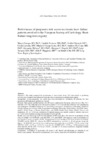Mostrar o rexistro simple do ítem
Performance of prognostic risk scores in chronic heart failure patients enrolled in the European Society of Cardiology Heart Failure long-term registry
| dc.contributor.author | Canepa, Marco | |
| dc.contributor.author | Fonseca, Candida | |
| dc.contributor.author | Chioncel, Ovidiu | |
| dc.contributor.author | Laroche, Cécile | |
| dc.contributor.author | Crespo-Leiro, María Generosa | |
| dc.contributor.author | Coats, Andrew J.S. | |
| dc.contributor.author | Mebazaa, Alexandre | |
| dc.date.accessioned | 2018-06-07T07:33:06Z | |
| dc.date.issued | 2018-06 | |
| dc.identifier.citation | Canepa M, Fonseca C, Chioncel O, Laroche C, Crespo-Leior MG, Coats AJS, et al. Performance of prognostic risk scores in chronic heart failure patients enrolled in the European Society of Cardiology Heart Failure long-term registry. JACC Heart Fail. 2018;6(6):452-462 | es_ES |
| dc.identifier.issn | 2213-1779 | |
| dc.identifier.issn | 2213-1787 | |
| dc.identifier.uri | http://hdl.handle.net/2183/20791 | |
| dc.description.abstract | [Abstract] Objectives. This study compared the performance of major heart failure (HF) risk models in predicting mortality and examined their utilization using data from a contemporary multinational registry. Background. Several prognostic risk scores have been developed for ambulatory HF patients, but their precision is still inadequate and their use limited. Methods. This registry enrolled patients with HF seen in participating European centers between May 2011 and April 2013. The following scores designed to estimate 1- to 2-year all-cause mortality were calculated in each participant: CHARM (Candesartan in Heart Failure-Assessment of Reduction in Mortality), GISSI-HF (Gruppo Italiano per lo Studio della Streptochinasi nell'Infarto Miocardico-Heart Failure), MAGGIC (Meta-analysis Global Group in Chronic Heart Failure), and SHFM (Seattle Heart Failure Model). Patients with hospitalized HF (n = 6,920) and ambulatory HF patients missing any variable needed to estimate each score (n = 3,267) were excluded, leaving a final sample of 6,161 patients. Results. At 1-year follow-up, 5,653 of 6,161 patients (91.8%) were alive. The observed-to-predicted survival ratios (CHARM: 1.10, GISSI-HF: 1.08, MAGGIC: 1.03, and SHFM: 0.98) suggested some overestimation of mortality by all scores except the SHFM. Overprediction occurred steadily across levels of risk using both the CHARM and the GISSI-HF, whereas the SHFM underpredicted mortality in all risk groups except the highest. The MAGGIC showed the best overall accuracy (area under the curve [AUC] = 0.743), similar to the GISSI-HF (AUC = 0.739; p = 0.419) but better than the CHARM (AUC = 0.729; p = 0.068) and particularly better than the SHFM (AUC = 0.714; p = 0.018). Less than 1% of patients received a prognostic estimate from their enrolling physician. Conclusions. Performance of prognostic risk scores is still limited and physicians are reluctant to use them in daily practice. The need for contemporary, more precise prognostic tools should be considered. | es_ES |
| dc.language.iso | eng | es_ES |
| dc.publisher | Elsevier | es_ES |
| dc.relation.uri | https://doi.org/10.1016/j.jchf.2018.02.001 | es_ES |
| dc.rights | Atribución-NoComercial-SinDerivadas 3.0 España | es_ES |
| dc.rights | © American College of Cardiology Foundation | es_ES |
| dc.rights.uri | http://creativecommons.org/licenses/by-nc-nd/3.0/es/ | * |
| dc.subject | Heart failure | es_ES |
| dc.subject | Mortality | es_ES |
| dc.subject | Prognosis | es_ES |
| dc.subject | Risk score | es_ES |
| dc.title | Performance of prognostic risk scores in chronic heart failure patients enrolled in the European Society of Cardiology Heart Failure long-term registry | es_ES |
| dc.type | info:eu-repo/semantics/article | es_ES |
| dc.rights.access | info:eu-repo/semantics/embargoedAccess | es_ES |
| dc.date.embargoEndDate | 2019-06-01 | es_ES |
| dc.date.embargoLift | 2019-06-01 | |
| UDC.journalTitle | JACC Heart Failure | es_ES |
| UDC.volume | 6 | es_ES |
| UDC.issue | 6 | es_ES |
| UDC.startPage | 452 | es_ES |
| UDC.endPage | 462 | es_ES |
Ficheiros no ítem
Este ítem aparece na(s) seguinte(s) colección(s)
-
INIBIC-ICATC - Artigos [177]






